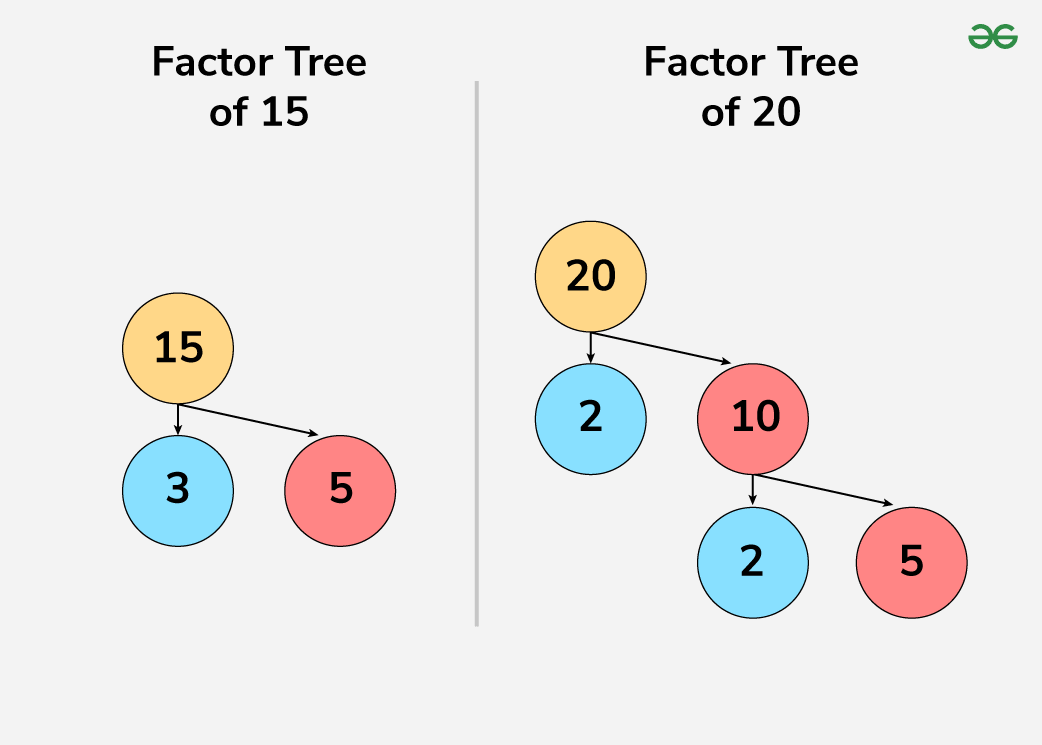
|
|
A factor tree is a simple and visual method used to find the prime factors of a number. It is a helpful tool in mathematics, especially for breaking down large numbers into their basic building blocks, known as prime factors. By repeatedly dividing a number into smaller factors until all remaining factors are prime, a factor tree helps students and learners understand the fundamental concepts of multiplication and prime numbers. For example, to factorize 36, you would start by dividing it by 2 (the smallest prime factor), resulting in 18. Continue dividing by 2 to get 9, and then divide by 3 to get 3. The factor tree for 36 would show that its prime factors are 2, 2, 3, and 3. In this article, we will discuss all things about factor trees, such as how to create them, their importance in prime factorization, step-by-step examples, and their applications in solving mathematical problems. 
Table of Content What is a Factor Tree?A factor tree is a graphical method used to break down a composite number into its prime factors. This visual representation simplifies the process of prime factorization, making it easier to see how a number can be divided into smaller prime numbers. It starts with the original number at the top and branches out into pairs of factors that multiply to form the number. This branching process continues until all the end branches are prime numbers, which cannot be factored further. Definition of Factor Tree
How to Create a Factor Tree?Here are the steps way to follow to create a factor tree:
Uses of Factor TreeFactor tree is a valuable tool in mathematics for several reasons, particularly in the context of prime factorization and understanding the properties of numbers. Here are some of its main uses:
Examples of Factor TreeFactor trees provide a systematic approach to break down numbers into their prime factors. Let’s look at some specific examples to understand the process better. Factor Tree of 120To factorize the number 120 using a factor tree:

So, the prime factorization of 120 is 2 × 2 × 2 × 3 × 5. Factor Tree of 72To factorize the number 72 using a factor tree:
The prime factors of 72 are 2, 2, 2, 3, and 3. 
So, the prime factorization of 72 is 2 × 2 × 2 × 3 × 3. Factor Tree of 24To factorize the number 24 using a factor tree:
The prime factors of 24 are 2, 2, 2, and 3. 
So, the prime factorization of 24 is 2 × 2 × 2 × 3. Factor Tree of 18To factorize the number 18 using a factor tree:
The prime factors of 18 are 2, 3, and 3. 
So, the prime factorization of 18 is 2 × 3 × 3. Applications of Factor TreesFactor trees have several important applications in mathematics, including
Let’s discuss these applications in detail with example. Finding Greatest Common Divisor (GCD) using Factor TreeThe greatest common divisor (GCD) is the largest number that divides two or more integers without leaving a remainder. To find the GCD using a factor tree:
Example : Finding GCD of 48 and 180 suing factor tree Factor Tree for 48 and 180
Finding Least Common Multiple (LCM) using Factor TreeThe least common multiple (LCM) is the smallest number that is a multiple of two or more integers. To find the LCM using a factor tree:
Example: Finding LCM of 15 and 20. Factor Tree for 15 and 20
Practice Problems on Factor TreeProblems 1: Factorize 45 using a factor tree. Problems 2: Create a factor tree for 100. Problems 3: Determine the prime factorization of 81 using a factor tree. Problems 4: Use a factor tree to find the prime factors of 56. Problems 5: Construct a factor tree for 144. Problems 6: Find the prime factors of 90 using a factor tree. ConclusionFactor trees are one of the many methods to find prime factorization of any number. Other methods use arithmetic operations to find the factors, whereas factor trees use visual approach. They provide a clear and visual method to break down complex numbers into their prime factors, making the learning process simpler and more intuitive. Using factor trees not only aids in educational development but also enhances problem-solving skills by providing a systematic approach to factorization. Factor Tree – FAQsWhat is the purpose of a factor tree?
Can 1 be in a factor tree?
Do factor trees show all factors?
Is factor and square root the same?
Can you factor in a radical?
|
Reffered: https://www.geeksforgeeks.org
| Mathematics |
Type: | Geek |
Category: | Coding |
Sub Category: | Tutorial |
Uploaded by: | Admin |
Views: | 12 |